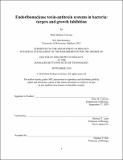Endoribonuclease toxin-antitoxin systems in bacteria : targets and growth inhibition
Author(s)
Culviner, Peter Holmes.
Download1138012902-MIT.pdf (5.121Mb)
Other Contributors
Massachusetts Institute of Technology. Department of Biology.
Advisor
Michael T. Laub.
Terms of use
Metadata
Show full item recordAbstract
Toxin-antitoxin (TA) systems are widely-distributed genetic modules that can reversibly inhibit the host bacteria's growth. Both toxin and antitoxin are encoded together on an operon and the antitoxin directly binds the toxin, preventing its activity. Under stressful conditions, the antitoxin may be degraded, allowing the toxin to inhibit growth. Bacteria often encode many copies of these mysterious systems and they have been suggested to play a role in a myriad of processes including plasmid maintenance, survival through antibiotic stress, growth regulation, and defense against bacteriophage. However, how TA systems might accomplish these diverse feats is not well understood. The toxic element of many of these systems is an endoribonuclease. In this work, I characterize the RNA targets of 9 endoribonuclease toxins encoded by the bacterium Escherichia coli. Previous studies had shown that the toxin MazF created a pool of leaderless mRNAs that were preferentially translated by specialized ribosomes created through MazF cleavage of the mature 16S rRNA. In my first project, I developed an RNA-sequencing-based pipeline to identify and quantify MazF cleavage across the transcriptome. I found that, in vivo, MazF does not generate appreciable quantities of specialized ribosomes nor leaderless transcripts. Instead, it degrades a large portion of E. coli transcripts, preventing their proper translation. Further, I found that MazF strongly inhibits the biogenesis of new ribosomes through both cleavage of nascent rRNA and inhibition of ribosomal protein synthesis. In my second project, I expanded this work to 8 other endoribonuclease toxins. I found that, like MazF, these toxins degrade a significant portion of E. coli transcripts, leading to a global inhibition of translation. Of particular interest, a number of these toxins are incapable of cleaving untranslated RNA such as rRNA but are still able to inhibit ribosome biosynthesis, likely through degrading ribosomal protein transcripts. I conclude that endoribonuclease toxins are efficient inhibitors of synthesis of macromolecular complexes.
Description
This electronic version was submitted by the student author. The certified thesis is available in the Institute Archives and Special Collections. Thesis: Ph. D., Massachusetts Institute of Technology, Department of Biology, 2019 Cataloged from student-submitted PDF version of thesis. Includes bibliographical references.
Date issued
2019Department
Massachusetts Institute of Technology. Department of BiologyPublisher
Massachusetts Institute of Technology
Keywords
Biology.